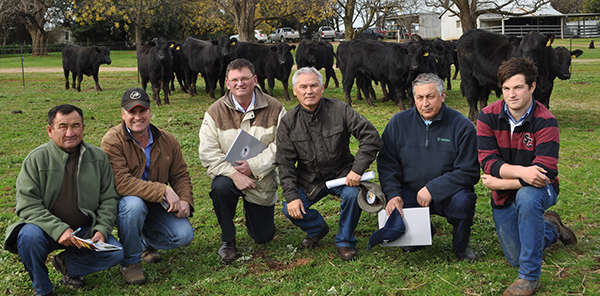By BRETT TINDAL – The Land, thurs Aug 8 2013
THE growing demand to feed the world is not just about available land, growing more crops or even the processed products we export around the world.
The big opportunity in the beef cattle industry is to supply animals and genetics to developing and rebuilding countries backed by their governments to secure food sustainability in their country.
This is the latest addition to selling and marketing cattle in Australia, with countries like Russia and Kazakhstan leading the rest of the world in sourcing Australian cattle to rebuild their depleted beef cattle industries to sure-up food in their countries.
A seven-day trip by two Kazakhstan veterinarians and a professor to finalise an order of 1100 predominantly Angus heifers and several Angus bulls was recently organised by Wellards Rural Exports, Melbourne, with 85 per cent of the cattle sourced and organised from clients of Australian Top Stock.
The three Kazakhstan visitors were led by Professor and Doctor of biological studies at the Kazakhstan National Agricultural University, Argibay Smaryaob.
Irelands Angus stud principal Corey Ireland said they sourced five bulls and 60 autumn-drop heifers from the stud for the current order.
The tour included several properties in Southern NSW – Irelands, Alpine, Ardrossan and Bongongo Angus studs.
Mr Smaryaob works for the Kazakhstan government helping to source and secure beef cattle from Australia, Canada and the US to develop a display farm with cattle from all over the world.
The idea behind the display farm was to gauge interest in their home country for the types of cattle available in other countries to rebuild their struggling beef industry, while at the same time compare the cattle from each country to decide what types of cattle suited their conditions before sourcing more.
Mr Smaryaob said before 1990 Kazakhstan had two million head, which had been depleted dramatically since then to less than 700,000 head and the plan was to get the country’s herd back to sustainable levels.
“The Kazakhstan government plans to see a further 74,000 head bought from overseas sources and predominantly Australia,” he said.
“Our local breed is Auliekolska, which is a white head breed, derived by crossing with Charolais and now the forebears of the Angus breed in Kazakhstan.”
Mr Smaryaob said this was the first trip for the three men to Australia, but they hoped to come back and source more cattle in several stages.
He said they liked the Angus breed as it complemented their Auliekolska breed.
“We have triple-checked them and we believe they are fool proof, hence why they will be used for breeding purposes to increase the quality of cattle in our home country,” he said.
The cattle sourced will arrive to very different climatic conditions with winter temperatures dropping to -15 degrees Celsius, while summer conditions average 20 degrees.
Beef cattle are raised on natural grass during spring and summer and barn fed during the colder months, with a current dry sheep equivalent of one cow to the hectare.
Mr Smaryaob said their processing sector was growing with imported equipment from Europe, with a lot of their processed beef currently being secured by Mongolia.
Mr Smaryaob said Kazakhstan had a long way to go to catch up to Australia, but through using their animals and genetics they can hopefully fast track their progress.
“Our dream is to not only export cows but also Australian farmers to help us rebuild the Kazakhstan beef industry to a competitive processor of quality beef,” he said.
Corey Ireland said the specifications for the Russian orders were heifers that were HBR or APR registered, with no genetic defects and weighing from 220 to 260 kilograms.
“The export market is becoming an important part of our program,” he said.
“We are seeing so much demand for our cattle from overseas that we must pay attention to the requirements and their needs.”
He said it was important, as with any market, to provide the correct product.
The cattle had to be structurally sound and heifers needed to have the potential to be good breeding cows.
“We don’t see it as an opportunity to offload all our second rate cattle but in fact an opportunity to send great young cattle that have a future over to a different country to monitor their actual performance in different,” he said.
“The overall size and potential to their cattle operations appears to be endless and it is exciting to be part of their overall development and establishment of their herd of Angus cattle.
“It is also great to work with people who are as passionate as we are about our cattle and from a different country.”
Caption: Kazakhstan beef producers in Australia to source bulls and heifers for their operation in Kazakhstan. Pictured are Kazakhstan Veterinarian Cavin Mahanbek, Irelands Angus stud principal Corey Ireland, Wagga Wagga, James Lilburne, Australia TopStock, Wagga, Professor and Doctor of Biological studies, Arigibay Smaryaob of Kazakhstan National Agricultural University, veterinary inspector Almamedov Gechumat, Kazakhstan and Melbourne based interpreter Alex Ilyin.


